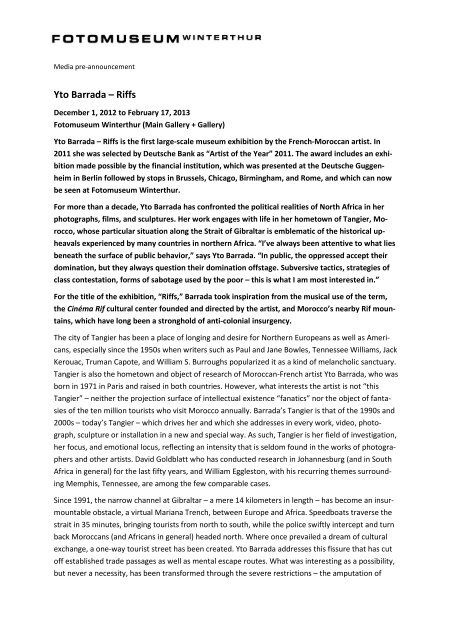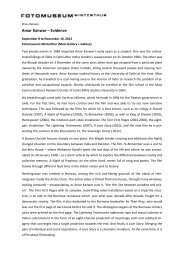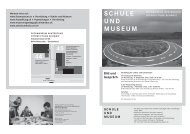Yto Barrada â Riffs - Fotomuseum Winterthur
Yto Barrada â Riffs - Fotomuseum Winterthur
Yto Barrada â Riffs - Fotomuseum Winterthur
You also want an ePaper? Increase the reach of your titles
YUMPU automatically turns print PDFs into web optimized ePapers that Google loves.
Media pre-announcement<br />
<strong>Yto</strong> <strong>Barrada</strong> – <strong>Riffs</strong><br />
December 1, 2012 to February 17, 2013<br />
<strong>Fotomuseum</strong> <strong>Winterthur</strong> (Main Gallery + Gallery)<br />
<strong>Yto</strong> <strong>Barrada</strong> – <strong>Riffs</strong> is the first large-scale museum exhibition by the French-Moroccan artist. In<br />
2011 she was selected by Deutsche Bank as “Artist of the Year” 2011. The award includes an exhibition<br />
made possible by the financial institution, which was presented at the Deutsche Guggenheim<br />
in Berlin followed by stops in Brussels, Chicago, Birmingham, and Rome, and which can now<br />
be seen at <strong>Fotomuseum</strong> <strong>Winterthur</strong>.<br />
For more than a decade, <strong>Yto</strong> <strong>Barrada</strong> has confronted the political realities of North Africa in her<br />
photographs, films, and sculptures. Her work engages with life in her hometown of Tangier, Morocco,<br />
whose particular situation along the Strait of Gibraltar is emblematic of the historical upheavals<br />
experienced by many countries in northern Africa. “I’ve always been attentive to what lies<br />
beneath the surface of public behavior,” says <strong>Yto</strong> <strong>Barrada</strong>. “In public, the oppressed accept their<br />
domination, but they always question their domination offstage. Subversive tactics, strategies of<br />
class contestation, forms of sabotage used by the poor – this is what I am most interested in.”<br />
For the title of the exhibition, “<strong>Riffs</strong>,” <strong>Barrada</strong> took inspiration from the musical use of the term,<br />
the Cinéma Rif cultural center founded and directed by the artist, and Morocco’s nearby Rif mountains,<br />
which have long been a stronghold of anti-colonial insurgency.<br />
The city of Tangier has been a place of longing and desire for Northern Europeans as well as Americans,<br />
especially since the 1950s when writers such as Paul and Jane Bowles, Tennessee Williams, Jack<br />
Kerouac, Truman Capote, and William S. Burroughs popularized it as a kind of melancholic sanctuary.<br />
Tangier is also the hometown and object of research of Moroccan-French artist <strong>Yto</strong> <strong>Barrada</strong>, who was<br />
born in 1971 in Paris and raised in both countries. However, what interests the artist is not “this<br />
Tangier” – neither the projection surface of intellectual existence “fanatics” nor the object of fantasies<br />
of the ten million tourists who visit Morocco annually. <strong>Barrada</strong>’s Tangier is that of the 1990s and<br />
2000s – today’s Tangier – which drives her and which she addresses in every work, video, photograph,<br />
sculpture or installation in a new and special way. As such, Tangier is her field of investigation,<br />
her focus, and emotional locus, reflecting an intensity that is seldom found in the works of photographers<br />
and other artists. David Goldblatt who has conducted research in Johannesburg (and in South<br />
Africa in general) for the last fifty years, and William Eggleston, with his recurring themes surrounding<br />
Memphis, Tennessee, are among the few comparable cases.<br />
Since 1991, the narrow channel at Gibraltar – a mere 14 kilometers in length – has become an insurmountable<br />
obstacle, a virtual Mariana Trench, between Europe and Africa. Speedboats traverse the<br />
strait in 35 minutes, bringing tourists from north to south, while the police swiftly intercept and turn<br />
back Moroccans (and Africans in general) headed north. Where once prevailed a dream of cultural<br />
exchange, a one-way tourist street has been created. <strong>Yto</strong> <strong>Barrada</strong> addresses this fissure that has cut<br />
off established trade passages as well as mental escape routes. What was interesting as a possibility,<br />
but never a necessity, has been transformed through the severe restrictions – the amputation of
North Africa – into an urgent desire. With calmly observant, restrained images, <strong>Yto</strong> <strong>Barrada</strong>’s photo<br />
series creates a climate of waiting, persistence, and circumnavigation.<br />
The border to Europe is not the only one. Tangier has developed internal trenches, and is rapidly<br />
evolving into a conformist real estate city. According to <strong>Barrada</strong>, 5000 building permits were issued in<br />
a single year. The city is expanding to the south into the countryside. Piece for piece, its empty spaces<br />
are disappearing as the uncertain and ambiguous are filled with new buildings and scattered settlements.<br />
Real estate capitalism paired with neoliberal politics is spreading, forcing its way through<br />
the historical architecture and preexisting land tenure. Such are the borders within the city itself,<br />
striations that constantly shift. In her photographs, <strong>Yto</strong> <strong>Barrada</strong> depicts how the new buildings<br />
spread, proliferation, take possession, and transform the city. In her video Beau Geste (2009), three<br />
men carefully tend and support a delicate palm tree. The tree activists <strong>Barrada</strong> portrays are working<br />
illegally, using small acts of civil disobedience to fight a law allowing landowners to build or sell their<br />
land as long as no fruit grows and no tree stands on it. The tree action becomes a form of “guerilla<br />
gardening,” which is intensely debated by observers who happen to be passing by.<br />
<strong>Yto</strong> <strong>Barrada</strong> monitors the changes in her city with hawk-like attentiveness, responding to them with<br />
actions, images, and films that nevertheless maintain a remarkable calm, distance, and restraint. Neither<br />
iconic nor bellicose, they do not purport to be a weapon of enlightenment, nor do they offer a<br />
complacent, arrogant visual world that knows exactly how to behave and what to attain. As if the<br />
artist would always take a step back, her quiet, nearly static square color photographs offer visual<br />
fields opening up onto a landscape, an urban constellation, a being, a repose. They reveal objects,<br />
buildings, and people so we might engage with them as observers, immersing ourselves, seeking,<br />
exploring, contemplating. We see here a sign and a gesture, there a rebellion; strikingly dedramatized,<br />
real and allegorical at the same time.<br />
<strong>Yto</strong> <strong>Barrada</strong> – <strong>Riffs</strong> was conceived by Friedhelm Hütte, responsible for the Deutsche Bank art program,<br />
and Marie Muracciole, independent curator and art critic.<br />
The accompanying catalogue with text contributions by Okwui Enwezor, Friedhelm Hütte, Marie Muracciole,<br />
and Daniel Soutif, as well as an interview by Negar Azimi with the artist may be purchased<br />
for CHF 49.-.







